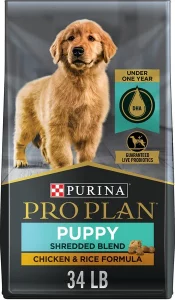Bringing Your Puppy Home
 Before we get into “Bringing your new puppy home, Chris and I want to Thank You for allowing us to be a part of your family. Understanding you have gone through a tremendous family transformation, I hope this information will help you “survive” puppyhood.
Before we get into “Bringing your new puppy home, Chris and I want to Thank You for allowing us to be a part of your family. Understanding you have gone through a tremendous family transformation, I hope this information will help you “survive” puppyhood.
By the time you picked up your puppy, Chris and I have already begun the well-puppy care and socialization process. Listed below are several very important topics.
Pre-Puppy Pick up
If this is your first puppy, we highly suggest “puppy proofing” your home prior to picking up your new family addition. Seemingly harmless household items like floor plants, decorations, shoes, clothing, children’s toys, etc., can become an easy choking hazard or may contain chemicals hazardous to your puppy. This includes topics such as where the puppy will be crated, where they will sleep, whether you permit them on the furniture, or where they are able to go within the house.
It is important to have some rules agreed upon beforehand. It is important that EVERYONE in the household understands what the rules are.
Puppies are a sponge and learn by the immediate results of their actions and no action is action. It’s your house, your rule! For example, if you don’t want the dog to ever get on your furniture, everyone in the household has to agree because the first time someone allows him on the couch, he will forever want on the couch.
Parvo:
CSB HIGHLY RECOMMENDS you DO NOT take your new puppy into public places such as pet stores, dog parks, or even family and friends’ houses until ALL VACCINATIONS have been completed. Unfortunately, you can’t account for the health and well-being of other dogs; you can expose your unvaccinated puppy to highly contagious and potentially fatal diseases such as PARVO.
With that said, you walk a fine line between socializing your puppy and exposing them to potential hazards – it’s all about managing risk.
First Vet Visit:
The best veterinarians have busy schedules, so if you know exactly when you’ll be picking your puppy up, call in advance to get a convenient appointment. Don’t wait until the last minute. You should also try to visit the clinic before your puppy comes home. Look around and see if you are at ease there, that the support staff seems friendly, and the facility is clean. Most vets will take the time to chat with prospective clients. This can be very helpful because you must be comfortable enough with this individual to ask questions. You will have lots of them when your new pup comes home, and you want someone who will treat your concerns with respect. In addition, find out about the clinic’s after-hours setup. One great truth about life with puppies is that emergencies rarely pop up from 9 to 5. Know what to do if your puppy gets an emergency in the middle of the night, including making plans for transportation to the facility. If it sounds much like having a new baby at home…it is! The problem is, puppies are mobile!
What to expect at the first visit:
-
- Weigh the puppy;
- Listen to the heart and lungs with a stethoscope;
- Take his temperature (note: pet temperatures are taken rectally);
- Examine the eyes, ears, nose, feet, and genitalia
- Examine skin and coat;
- Look at teeth and mouth;
- Palpate abdomen and lymph nodes;
- Examine feces for the presence of worms (most pups may have roundworms);
Discuss the puppy’s history and any questions you might have about feeding, medical issues, such as worm medications, and future care. This is also a good time to discuss spaying and neutering timetables.
If you are going home with medications or treatments, make sure that you understand when and how they are to be given. Follow directions to the letter, and set up a schedule for follow-up visits and vaccinations.
Vaccination Schedule
When you pick up your puppy, we will provide you will a complete medical and vaccination record of your puppy. Along with shot and medical records, you will receive a copy of our “Puppy Care Schedule Worksheet” which documents everything that has been given, the doses, and schedules out to 16 weeks.
-
- 3 – 4 Weeks: As part of CSB’s standard protocol, we give a PARVO only vaccination between 3 and 4 weeks.
- 6 – 8 Weeks:(5-Way) Distemper, Adenovirus, Hepatitis, Parvovirus, Parainfluenza.
- 10-12 Weeks: (5-Way) Distemper, Adenovirus, Hepatitis, Parvovirus, Parainfluenza.
- 14-16 Weeks:(9-Way) Distemper, Adenovirus, Hepatitis, Parvovirus, Parainfluenza, and protects against four strains of Lepto.
- 18-20 Weeks: (9-Way) Distemper, Adenovirus, Hepatitis, Parvovirus, Parainfluenza, and protects against four strains of Lepto.
- 12-24 Weeks: Rabies: This vaccination can only be given by a DVM
Feeding Your Puppy:
 We feed our puppy dogs Purina Pro Plan Puppy Chicken and Rice-Shredded. In our daily puppy food, we give a coccidia preventative that helps keep the puppy and mother healthy. As part of your Puppy Package, we provided you with a large zip-lock back of food; although you may have already purchased a bag, please continue to feed the food that we provide at delivery until it is all gone. This will help prevent any digestive issues caused by the stress of moving.
We feed our puppy dogs Purina Pro Plan Puppy Chicken and Rice-Shredded. In our daily puppy food, we give a coccidia preventative that helps keep the puppy and mother healthy. As part of your Puppy Package, we provided you with a large zip-lock back of food; although you may have already purchased a bag, please continue to feed the food that we provide at delivery until it is all gone. This will help prevent any digestive issues caused by the stress of moving.
Pro Plan can be widely found in places like pet stores such as Tractor Supply or higher-end grocery stores. Pro Plan is the ONLY Purina product we recommend. Our adult dogs are fed Diamond Natural Products, and we would suggest those if you find Pro Plan hard to find.
When changing food, gradually replace the Pro Plan with your high-quality replacement. Making any sudden changes may cause the puppy digestive problems. We also, mix a small portion of a high-quality wet (or can) food into each meal. This adds needed calories and gives the puppies a little moisture. We are currently using 4-Health products from Tractor Supply.
-
- 6–12 weeks: Four feedings a day are usually adequate to meet nutritional demands. We suggest slightly “softening” the food with warm water before feeding and including a tablespoon or two of high-quality wet food. This will be more appealing and easier for the puppy to eat. Plus, by wetting it, you are also providing additional liquid.
- 3–6 months: Sometime during this period, decrease feedings from four to three a day. A pup should be losing her potbelly and pudginess by 12 weeks. If they are still roly-poly at this age, continue to feed puppy-size portions until body type matures.
- 6–12 months: Begin feeding twice daily. Spaying or neutering lowers energy requirements slightly; after the procedure, switch from nutrient-rich puppy food to adult maintenance food. Error on the side of caution: Better to be on puppy food a little too long than not long enough. Whenever switching food, gradually replace the new with the old. Any sudden change in food can result in digestive issues.
- 1 Year: Most owners feed adult dogs two half-portions a day.
Treats:
Treats are the best way to begin your relationship with your new puppy. However, we do have several precautions. In your Puppy Package, we provide any treats your puppy has been exposed to, typically they are very few. We HIGHLY suggest holding off on a lot of treats at first and letting your puppy get settled into their new surrounding.
-
- First and foremost – NO RAWHIDE.
- Moderation is the key, as too many treats may upset your puppy’s digestive system.
- Stick to one type/brand of a treat at a time. If you offer your puppy different types of treats and he has a reaction, you don’t know which treat has a negative effect.
Toys:
BE CAREFUL with toys. In general, Olde English Bulldogges are “gulpers” ; therefore, you have to be very careful about what toys and treats you use. Generally, we stay away from anything that squeaks, as the small plastic squeaker can become a choking hazard. We suggest ropes, tires, and “bully-proof” type toys. Just remember, they will tear it up and you need to pay attention to what is inside.